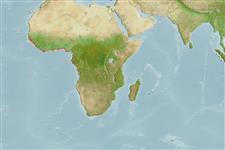Common names from other countries
Environment: milieu / climate zone / depth range / distribution range
Ecologia
marinhas; Água doce; estuarina bentopelágico. Tropical; 22°C - 26°C (Ref. 2059); 16°N - 12°S, 17°W - 16°E
Africa: coastal basins, fresh waters, brackish and marine waters from mouth of Senegal River (Senegal) to mouth of the Cuanza River (Angola) (Ref. 81260), sometimes ascending far up rivers.
Comprimento de primeira maturação / Tamanho / Peso / Idade
Maturity: Lm 13.5, range 10 - ? cm
Max length : 30.0 cm SL macho/indeterminado; (Ref. 31256)
Espinhos dorsais (total): 14 - 16; Raios dorsais (total): 12-13; Espinhos anais 3; Raios anais : 8 - 10. Diagnosis: upper profile of head strongly convex; lower pharyngeal bone about as long as broad, and with anterior lamella shorter than toothed area (Ref. 53405). 10 or fewer rakers on lower limb of first arch; unpaired fins not predominantly red-brown; mouth terminal; 29-30 scales on lateral line; outer row teeth robust (Ref. 81260). Dorsal fin with 14-16 spines and 12-13 soft rays (total rays 27-29) (Ref. 53405, 81260). Anal fin with 3 spines and 8-10 soft rays; caudal fin weakly covered with scales at base or entirely membranous (Ref. 81260). Caudal without spots, grey on upper lobe, yellow on lower; large vertical stripes weakly pronounced on flanks; flank scales with a blackish mark at base (Ref. 53405, 81260). No bifurcated dark vertical bars on flanks; dorsal and anal without orange-red upper margin (Ref. 53405). Length of caudal peduncle 10.5-12.9% of standard length (Ref. 81260).
Very tolerant of elevated salinities, found in pure seawater, even reproduction in these highly saline environments is possible (Ref. 52307). Feeds on shrimps, bivalves, plankton (Ref. 28587), detritus (Ref. 28587, 52307), higher plants, algae, aufwuchs and small crustaceans (Ref. 52307). Oviparous (Ref. 205). Very prolific, spawning up to every 3 weeks (Ref. 52307). Pair bonding, open (Ref. 52307) substrate brooder/spawner (Ref. 52307, 81260) with both parents guarding the brood (Ref. 52307).
Oviparous (Ref. 205). Subtrate guarding of eggs as a form of parental care is done by both male and female (Ref. 50828).
Dunz, A.R. and U.K. Schliewen, 2013. Molecular phylogeny and revised classification of the haplotilapiine cichlid fishes formerly referred to as "Tilapia". Mol. Phylogenet. Evol. 68(1):64-80. (Ref. 93285)
Status na Lista Vermelha da UICN (Ref. 130435)
CITES (Ref. 128078)
Not Evaluated
Ameaça para os humanos
Harmless
Uso pelos humanos
Pescarias: espécies comerciais; Aquacultura: espécies comerciais
Mais informação
ColaboradoresFotosStamps, Coins Misc.SonsCiguateraVelocidadeTipo de nataçãoÁrea branquialOtólitosCérebrosVisão
Ferramentas
Relatórios especiais
Baixar XML
Fontes da internet
Estimates based on models
Preferred temperature (Ref.
115969): 25.5 - 28, mean 27.4 (based on 152 cells).
Índice de diversidade filogenética (Ref.
82804): PD
50 = 0.5000 [Uniqueness, from 0.5 = low to 2.0 = high].
Bayesian length-weight: a=0.01514 (0.00942 - 0.02431), b=2.96 (2.83 - 3.09), in cm Total Length, based on LWR estimates for this species & (Sub)family-body (Ref.
93245).
Nível Trófico (Ref.
69278): 2.8 ±0.33 se; based on food items.
Resiliência (Ref.
120179): Elevada, tempo mínimo de duplicação da população menor que 15 meses (K=0.47; Fec < 1,000).
Fishing Vulnerability (Ref.
59153): Low vulnerability (19 of 100).
